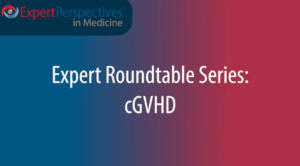Oncology
Chronic Graft-versus-Host Disease
Predictors of Outcomes in Patients With Chronic Graft-versus-Host Disease
When I see a patient with newly diagnosed cGVHD, I use clinical tools to risk stratify them, traditionally, the National Institutes of Health (NIH) Global Severity Score. This measure classifies patients as having mild, moderate, or severe cGVHD. Moderate to severe cGVHD is associated with worse nonrelapse mortality and overall survival. Therefore, systemic therapy is usually indicated for these patients. If a patient is classified as having mild disease without high-risk features, management with topical treatment is adequate. However, if high-risk features are present, including platelet count of less than 100,000/μL and elevated bilirubin levels of greater than 2 mg/dL, prognosis can be worse. Thus, systemic therapy is warranted in patients with mild cGVHD with concurrent high-risk features. Individuals with multiorgan dysfunction, visceral involvement, or bronchiolitis obliterans also have a worse prognosis. If cGVHD develops earlier posttransplant or while someone is receiving corticosteroids, it tends to be more aggressive. Other signals for prognosis include how cGVHD is responding to treatment and if the patient has steroid-dependent or -refractory cGVHD.
<br>
Patient-reported outcomes are also an indicator of prognosis. Thus, the utility of patient-reported outcomes is being recognized, and adoption has increased more recently. These metrics measure how patients feel overall, their symptoms, and their quality of life (QOL). One such example is skin involvement with sclerotic changes because that can reduce QOL. Sometimes we focus on treating patients based on their symptoms but forget that they could also be having other challenges (eg, emotional distress, difficulty sleeping, and muscle weakness). Newer clinical trials in cGVHD have started to incorporate these metrics, which I am happy to see because they give us a fuller picture.
<br>
Putting it all together, we have a multitude of metrics with clinical, laboratory, QOL, and biomarker data. Thus, we are actively working to integrate these variables into a more formal and comprehensive framework for prognostication in cGVHD, with the goal of informing and optimizing future therapeutic strategies. This ongoing investigation leverages multidimensional data to refine risk assessment. Importantly, traditional prognostic indicators for survival and nonrelapse mortality may be evolving with the introduction of newly US Food and Drug Administration (FDA)–approved therapies, as many were originally developed prior to recent FDA approvals. As novel treatments emerge and our understanding of QOL metrics deepens, these efforts are expected to culminate in a more contemporary and dynamic risk stratification model for patients with cGVHD.
Brassil K, Halpenny B, Arthur E, et al. TIP25-244: Comprehensive Outcomes for After Cancer Health (COACH) Study: 2024 trial in progress updates. J Natl Compr Canc Netw. 2025;23(3.5):TIP25-244. doi:10.6004/jnccn.2024.7231
<br>
El Jurdi N, Herzog S, Shanley R, Holtan SG, MacMillan ML, Weisdorf DJ. Treatment-sensitive and treatment-dependent chronic graft-versus-host disease yield superior failure-free and overall survival compared to treatment-resistant chronic graft-versus-host disease. Transplant Cell Ther. 2024;30(6):616-625. doi:10.1016/j.jtct.2024.03.011
<br>
Im A, Pusic I, Onstad L, et al. Patient-reported treatment response in chronic graft-versus-host disease. Haematologica. 2024;109(1):143-150. doi:10.3324/haematol.2023.282734
<br>
Jagasia MH, Greinix HT, Arora M, et al. National Institutes of Health consensus development project on criteria for clinical trials in chronic graft-versus-host disease: I. The 2014 Diagnosis and Staging Working Group report. Biol Blood Marrow Transplant. 2015;21(3):389-401.e1. doi:10.1016/j.bbmt.2014.12.001
<br>
Jiang J, Sigmund AM, Zhao Q, et al. Impact of chronic graft-versus-host disease on non-relapse mortality and survival. Leuk Lymphoma. 2024;65(11):1698-1705. doi:10.1080/10428194.2024.2365910
<br>
Oyama T, Matsuda K, Honda A, et al. Clinical characteristics of steroid-responsive but dependent chronic graft-versus-host disease: a multicenter retrospective analysis. Int J Hematol. 2023;117(2):260-268. doi:10.1007/s12185-022-03471-0
<br>
Ponce DM, El-Jawahri A, Hamilton BK, et al. Trial in progress: patient-reported outcome measures in the prospective observational cohort study of patients at risk for chronic graft-versus-host disease in the United States (THRIVE). Blood. 2023;142(suppl 1):7035. doi:10.1182/blood-2023-178073











